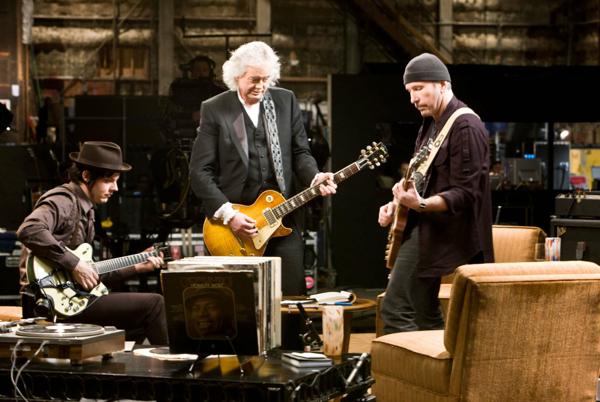Movie review by Greg Carlson
As beautiful and exciting as the music made by its trio of subjects, “It Might Get Loud” is a warmly engaging documentary that will please and delight longtime fans of Led Zeppelin, U2, and the White Stripes. The movie will also most certainly create new admirers. Conceived by producer Thomas Tull, “It Might Get Loud” manages a fresh take on the rock movie, focusing attention on the intimate relationship between musician and instrument instead of the sometimes caustic connection between obsessive fan and egomaniacal, self-indulgent superstar. What unfolds is a character-driven portrait of the working methods, inspirations, and personal histories of Jimmy Page, the Edge, and Jack White.
Elegantly assembled by director Davis Guggenheim, “It Might Get Loud” alternates between individual vignettes and a Los Angeles soundstage meeting dubbed the “Summit” – an unscripted guitar clinic/conversation that progresses from tentative and guarded conference to full blown jam session. In some of the most thrilling scenes in the movie, the guitarists take turns teaching signature riffs. The Edge rings out “I Will Follow,” White takes apart “Dead Leaves and the Dirty Ground” and Page blows the minds of his younger counterparts with the monstrous grind of “Whole Lotta Love” as Edge and White break into broad smiles.
Outside the “Summit” and the visits to each player’s home turf, Guggenheim and his collaborators dish up a wealth of archival material. Short animated segments illustrate anecdotes including a tale about White’s cluttered bedroom and a visual expression of the Edge’s fascination with return echo that, as he describes it, “fill[s] in notes that I’m not playing, like two guitar players rather than one.” Mindful of the age and generational differences among the artists, Guggenheim contrasts their attitudes and styles, most noticeably how the Edge’s multilayered special effects wizardry departs from White’s insistence on self-imposed primitivism (even though the film makes clear that all three of its participants embrace invention and experimentation).
The strong personalities of Page, Edge, and White complement the movie’s focus on the power of song; at various points the men identify tracks of deep personal impact in their artistic journeys. The startlingly confidential snapshots – Page launching into impromptu air-guitar to Link Wray’s glorious “Rumble,” Edge’s epiphany at the raw intensity of do-it-yourself bands like the Ramones, the Clash, and the Buzzcocks, and White’s revelatory bewilderment at the Flat Duo Jets’ interpretation of “Froggie Went a Courtin’” and Son House’s “Grinnin’ in Your Face” – have an oddly moving way of reminding viewers that all masters were once beginners.
In the final scenes, Page, Edge, and White morph into a howling Cerberus as they tear through “In My Time of Dying.” Then, following a brief coda that salutes the value of fortune and timing, they get together on the Band’s “The Weight,” the kind of sturdy ballad beloved by listeners and practitioners alike. One imagines that while all appreciated the results of the “Summit,” relative youngster White left feeling good about standing shoulder to shoulder with a veteran sonic innovator and an elder statesman who carries living legend status. With those kinds of influences close at hand, I can’t wait to hear the next White Stripes record.
